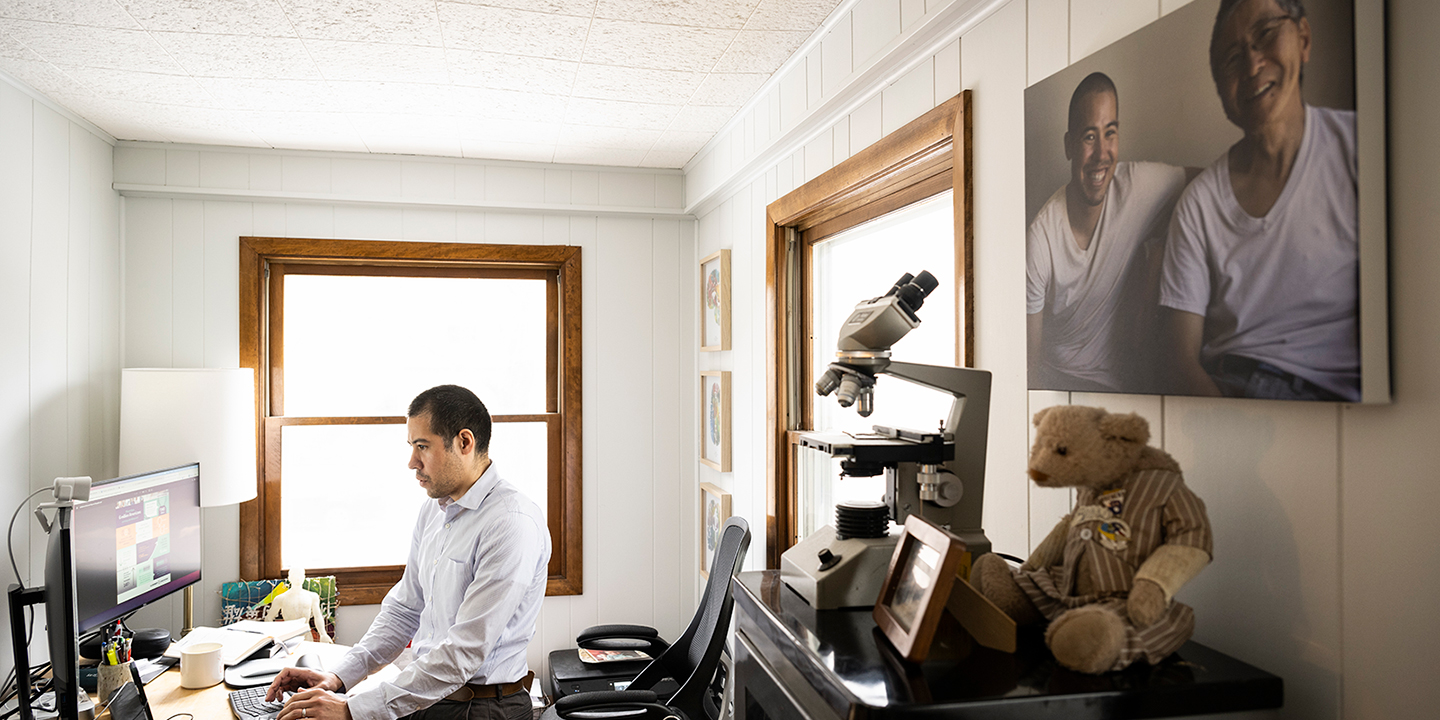
Progress on Alzheimer’s Disease
According to UW geriatrician Nathaniel Chin '06, MD'10, "We are on a trajectory for prevention."
The Initiative to End Alzheimer’s is one of the primary areas of support for the Wisconsin Medicine campaign, which raises funds for UW Health and the UW School of Medicine and Public Health.
During a holiday visit home in 2012, Nathaniel Chin ’06, MD’10 sat down with his mother for a talk — an event that changed his life. At the time, Chin was doing his internal medicine residency in California. He planned to specialize in infectious diseases.
For nearly 40 years, his father, Moe, a first-generation American, had been a doctor in Watertown, Wisconsin. Working as many as 100 hours a week, he treated everyone in town from birth to death. Growing up, Nate often watched his father as he left home late at night toting his black leather physician’s satchel. The next morning, as he went to school, he would greet his father coming back.
On that fateful day in 2012, Chin learned that Moe probably had Alzheimer’s disease. His father couldn’t remember what he was watching on television or recognize their car in parking lots. “I can close my eyes, be back in that room, and remember the tears on my face,” says Chin, who abruptly changed his career plans. He would now care for Alzheimer’s patients.
After finishing his residency, Chin returned to University Hospital and became a memory care geriatrician. In his spare time, he made the hour-long trip to Watertown to help his mother. He fed, bathed, and cleaned Moe, who passed away at home at age 66, six years after his diagnosis.
Today Chin is an assistant professor in the UW Department of Medicine and the medical director of the UW’s widely respected Alzheimer’s Disease Research Center (ADRC), one of the nation’s 33 federally funded research hubs studying the condition. Founded in 2009, it supports 42 scientists and dozens of investigators seeking to improve early Alzheimer’s detection and to arrest the disease’s onset and progression.
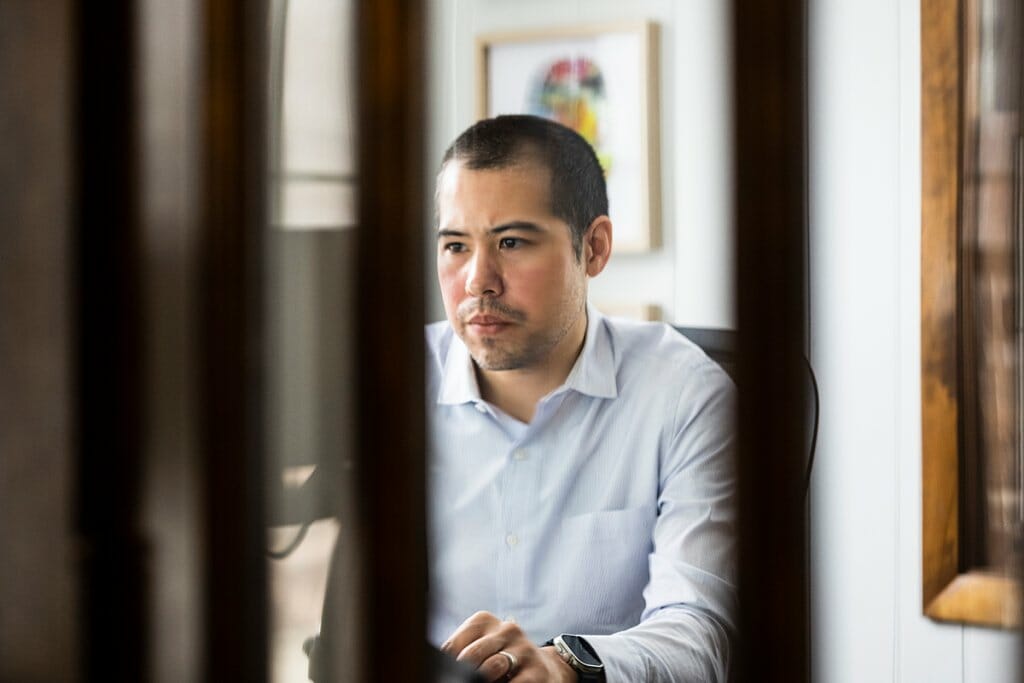
Chin is the medical director of the UW’s widely respected Alzheimer’s Disease Research Center.
Chin is also the medical director of the Wisconsin Registry for Alzheimer’s Prevention (WRAP), one of the world’s largest and longest-running studies of individuals at risk for Alzheimer’s disease. Its 1,700 mostly middle-aged volunteers have close relatives with Alzheimer’s. They make every-other-year visits for testing to gauge their mental status.
More than six million Americans and about 50 million people around the world have Alzheimer’s, numbers that will likely double by 2050. Through funding from the National Institute on Aging and the National Institutes of Health, the ADRC seeks improved diagnosis and care for patients while pursuing an ambitious long-term goal: preventing and treating Alzheimer’s disease. It marshals academic, clinical, and research expertise from the UW School of Medicine and Public Health, UW Health, and the William S. Middleton Memorial Veterans Hospital.
Chin believes that over the next 20 years, new drugs will likely block Alzheimer’s progress in people who have been diagnosed. They may even halt the onset of symptoms. “We are on the trajectory for prevention,” he says. “Making Alzheimer’s a chronic condition instead of one that’s terminal is not only feasible, but it seems we’re getting closer and closer to that.”
A Fast-Moving Field
Chin inherited his father’s confident bedside manner. His voice is as soft and gentle as Mister Rogers’s. He has an open face. His smile beams. His eyes sparkle. It is easy to imagine caregivers and patients pouring out their hearts to him.
Like his father, Chin stays busy. He sees patients two days a week in the UW’s memory clinics; acts as a dementia consultant for a local nursing home; teaches residents how to evaluate patients who may have memory disorders; and sits on boards for the Alzheimer’s Foundation of America and Alzheimer’s Association Wisconsin Chapter. As host of the popular podcast Dementia Matters (see sidebar), he has become one of the nation’s best-known figures in the field of Alzheimer’s medicine.

Chin with his father’s scuffed physician’s satchel.
Chin keeps Moe close in his heart and thoughts. In his home office, the silvery Fisher Scientific microscope that was his father’s has a place of honor atop a cabinet. A stark centerpiece greets visitors in his living room. It is the ultimate talisman, battered, scuffed, scarred, and tattered from decades of use: his father’s black bag.
Even with a toddler and a newborn at home, Chin puts in 80 hours a week. “I feel like I’m always behind, because every week there’s a new finding or study,” he says. “I think two years from now, based on how fast this field is progressing, it’s going to look completely different.”
One major advance is the drug that doctors like Chin have been waiting for: lecanemab. Approved using the accelerated approval pathway by the Food and Drug Administration in January, it does not stop Alzheimer’s. It poses risks such as brain bleeding and swelling. Its benefits may be modest or short-lived. But in a recent trial of 1,800 volunteers with mild mental impairment, lecanemab slowed their cognitive decline by 27 percent over 18 months. It did this by reducing their levels of amyloid, a protein that clumps into plaques in the brains of people with the disease.
For more than 20 years, drug trials targeting amyloid went nowhere, so lecanemab’s approval gives Chin hope. “It’s better than anything we have now, and I’m pretty excited about that,” he says. “Lecanemab is a game changer in a lot of ways. Its accelerated approval is going to change the research landscape and direct its trajectory for the foreseeable future.”
While some researchers dismiss lecanemab’s effectiveness as too modest to make a difference, Chin disagrees. “That five- to six-month extension of current ability may not sound like a lot, but if we were talking about cancer, that would be quite significant, and everyone would approve of such a drug.”
Today, doctors routinely order cholesterol blood tests as part of checkups. Chin predicts that at annual exams in the future, they will do brief verbal thinking tests. These quizzes might start at around age 45 or even earlier, because Alzheimer’s can lurk in the brain for 20 years before symptoms arise. Following that mental exam, future physicians would order tests to look for biomarkers (molecules) of Alzheimer’s in a patient’s blood. If the results are positive, the doctor would write an amyloid-lowering prescription just as statins manage cholesterol levels. (Such Alzheimer’s blood tests currently exist but are expensive.)
Researchers are still struggling to figure out the underlying mechanisms of Alzheimer’s. “Unlike polio where, boom, we identified its cause, we are probably going to have to identify many different pathways relating to insulin, inflammation, the immune systems, and so forth,” Chin says.
“Every week there’s a new finding or study. I think two years from now, based on how fast this field is progressing, it’s going to look completely different.”
“What’s exciting for us in Wisconsin is we have researchers looking at reversible factors. We have researchers looking at insulin. We are well positioned to reinforce those studies or collaborate with others.”
Jason Karlawish, codirector of the Penn Memory Center in Philadelphia, admits that “we’re all kind of jealous of what’s going on in Wisconsin. From the beginning, Wisconsin has stood out for its leadership. It was the only center founded by a geriatrician. Today it has an elegant combination of geriatricians, psychologists, and neurologists working together. It’s a marquee center, one of the jewels in the crown. Its leaders do their work in a calm, collegial atmosphere. It’s really inspiring.”
A More Personalized Approach
Like Chin, Cynthia Carlsson MS’05 has a personal history with Alzheimer’s. As a middle schooler, she felt helpless watching her grandmother Mimi decline. Mimi put mayonnaise in the spaghetti sauce and lost the ability to make her famous cookies. Today Carlsson is a professor in the UW Department of Medicine and shares leadership of the ADRC’s research with Chin, heading its clinical trials.
She leads the Wisconsin arm of the global AHEAD study. Its volunteers, all middle-aged and older, have no symptoms, but they do have elevated amyloid levels, and many have relatives with dementia. Over a four-year period, they will be given lecanemab versus a placebo to see if tailored dosing slows or stops the disease or prevents the onset of symptoms. “The overall hope is that we’ll be able to find people with early brain changes in amyloid and identify personalized, tailored therapies,” she says.
Biomarker analysis has made great strides at Wisconsin, according to Chin’s colleague Sterling Johnson, professor in the UW Department of Medicine and principal investigator for the Wisconsin Registry for Alzheimer’s Prevention.
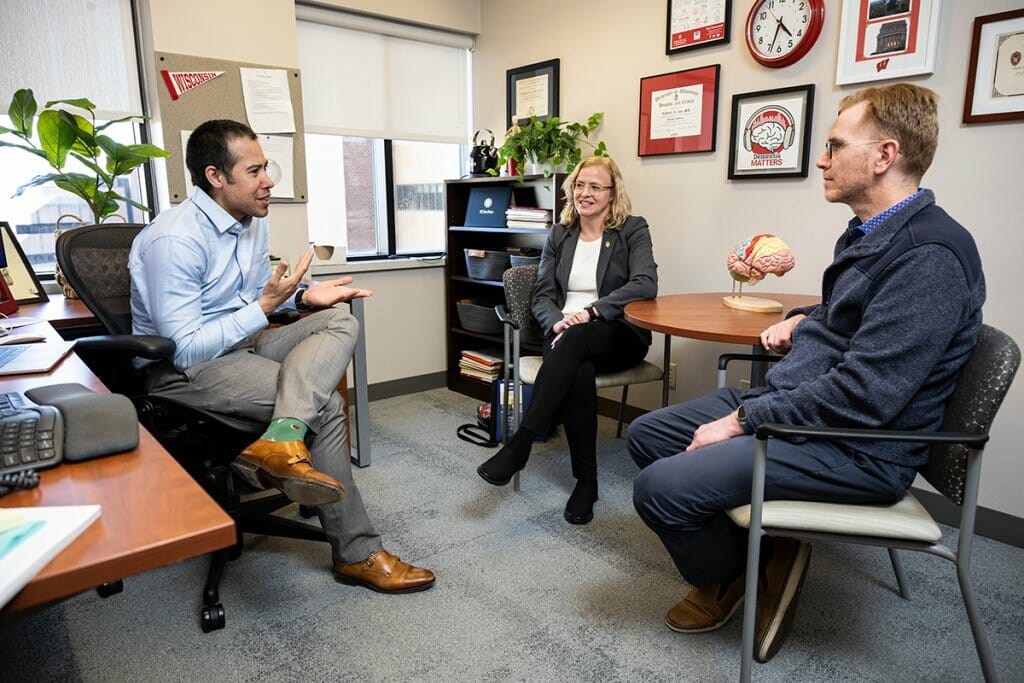
Chin, Carlsson, and Johnson meet at University Hospital to discuss the ambitious long-term goal of preventing and treating Alzheimer’s disease.
Unlike Carlsson and Chin, Johnson had no close relative with Alzheimer’s. But as a child, he was curious about how things worked. He loved to take apart toys and bicycles. “That curiosity is something that has stayed with me, and now I’m dealing with the most complex organ — the brain,” he says.
Johnson took over from WRAP’s founder, Mark Sager, when he retired. “Sterling has revolutionized WRAP and made it a powerhouse of data and analysis,” Chin says.
For years, select WRAP volunteers have undergone PET scans or spinal fluid tests. The results have allowed Johnson to identify early brain changes and pinpoint the date when their brain cells began dying. “This gives us a contextual anchor point to understand why some people develop symptoms early and some later,” he says. “It’s going to help us create a more personalized approach to treating Alzheimer’s.”
Female, Black, and Hispanic populations are more susceptible to Alzheimer’s than other groups. Nearly a fifth of WRAP volunteers come from underrepresented populations, and Johnson hopes to boost that percentage.
The scientific value of the WRAP study is increasing because it now has 20 years of cognitive data. “WRAP is rapidly becoming the study identified with early identification of Alzheimer’s,” Johnson says. “When researchers anywhere on the globe think about preclinical Alzheimer’s, they think about WRAP. I’m so proud of that.”
Push through the Denial
Chin hops in his 2010 Prius at 7:45 a.m. for his quick commute to University Hospital. The car was once his father’s. “I’ll never get rid of it until it’s absolutely dead,” he insists.
Coffee is always with him on the drive. Some things are never in his mug — milk, sugar, and artificial sweeteners. Instead, Chin doses his brew with cinnamon and turmeric. Both have anti-inflammatory properties that may help brain function.
The trauma of Moe’s decline changed Chin. Warding off Alzheimer’s now governs what he eats and how he exercises and sleeps. For the past five years, he has practiced intermittent fasting. He dines only between noon and 6 p.m. Restricting eating hours lowers blood pressure and alters brain chemistry, both of which can boost brain health. Chin limits red meat, most carbs, and dairy products, except cheese. He loads up on white meat, berries, and salads with olive-oil-based dressing.
Getting eight hours of sleep forms the heart of his daily routine. “Sleep is the most foundational thing we can do,” he says. “Less than six hours a night is dangerous.”
Chin is quick to note that just because a relative had Alzheimer’s does not mean a child will get it, though some families do have a genetic risk marker.
He could take a test to learn if he has it, but he prefers not to. “The psychological consequences would be too great,” he says. “I don’t want a private company to have that information. Anyway, there’s no medication I could take to protect myself. For most of us, getting Alzheimer’s is likely a combination of things, some of which we can control, some we can’t. You do the best you can.”
Chin does the best he can for himself with his own family in mind.
“Certainly now that I have children, I want to be around for them,” he says.
Chin has advice for families in crisis due to a loved one’s diagnosis. “Push through the denial. You’re going to need to come together, not only for the patient but for the primary caregiver who is typically a woman. Support her. Create a system. Be honest with each other.”
Chin also recommends savoring interactions with loved ones diagnosed with Alzheimer’s. “Enjoy each moment. The reality is they are the best now they are going to be. Prepare for behavior and personality changes, but also enjoy the time you have,” he says. “Don’t let it slip by.” •
Freelance writer George Spencer is a former executive editor of the Dartmouth Alumni Magazine.
Published in the Summer 2023 issue
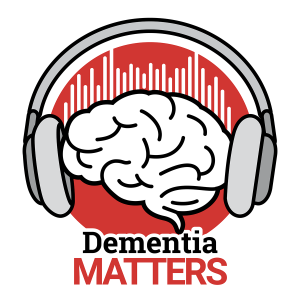

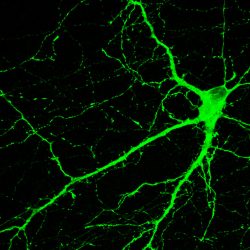
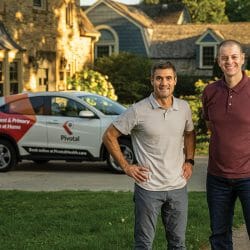
Comments
Chris Galligan June 12, 2023
Very informative and encouraging article.Thsnk you. Since I follow this closely, would have liked to see where their BRAVE study stands with epa.? I forwarded this to many colleagues with very positive feedback. Very well written Chis Galligan ’74 Hamilton, MA.
Timothy F Quadracci June 20, 2023
My wife, Judy was diagnosed with Alzheimer’s in this past January by Dr. Lisa Kokontis in Neenah, Wi. We are hoping for the approval by Medicare on paying for Lecanemab and any future HOPES.
Sally Borchardt August 18, 2023
Fantastic research, hope it continues .